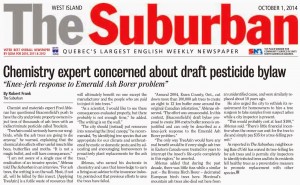
“Knee-jerk response to Emerald Ash Borer problem”
By Robert Frank
www.thesuburban.com
Chemist and materials expert Fred Ablenas has questioned Beaconsfield’s push to have the city and private property owners inject tens of thousands of ash trees with an indiscriminate pesticide called TreeAzin.
“TreeAzin could seriously harm our songbirds, while the ash trees are going to die anyway,” he warned, explaining that the chemical also affects other useful insects like bees, butterflies and moths. “It is not a magic bullet, and will have consequences.”
“I am not aware of a single case of the eradication of an invasive species,” Ablenas told The Suburban in an interview. “For ash trees, the writing is on the wall. Most, if not all, will be killed by this insect. [Applying TreeAzin] is a futile waste of resources that will ultimately benefit no one except the manufacturer and the people who are paid to inject it into trees.”
“As a scientist, I would like to see these consequences evaluated properly, but there probably is not enough time,” he added. “The writing is on the wall.”
“The city should [instead] put resources into renewing the [tree] canopy,” he recommended, “by identifying tree species that are appropriate for our climate and unthreatened by exotic or domestic pests; and by educating and encouraging homeowners to proactively plant replacements for the ash trees.”
Ablenas, who earned his doctorate in chemistry and uses that knowledge to earn a living as an advisor to the insurance industry, pointed out that previous efforts to save the trees have failed.
“Around 2004, Essex County, Ont., cut down more than 100,000 ash trees to create an eight to 12 km buffer zone around the original Canadian infestation,” Ablenas observed. “The effort was unsuccessful. In this context, [Beaconsfield’s] draft bylaw proposal to create 100-metre buffer zones is unjustified and can only be described as a knee-jerk response to the Emerald Ash Borer problem.”
“The only way TreeAzin would have any real benefit would be if every single ash tree in Eastern Canada were treated for years to interrupt the insect’s life-cycle completely in this region,” he asserted.
Ablenas added that during the past decade, there was little fuss while a similar pest—the bronze birch borer—decimated European birch trees here. Montreal’s mountain ash trees also died out here from an unidentified cause, and were similarly replaced about ten years ago.
He also urged the city to rethink its requirement for homeowners to hire a tree surgeon to take samples from suspect ashes while a city inspector is present.
“This would probably cost at least $100,” Ablenas said. “There’s little financial incentive when the owner can wait for the tree to die and simply pay $35 for a tree-felling permit.”
(function(i,s,o,g,r,a,m){i[‘GoogleAnalyticsObject’]=r;i[r]=i[r]||function(){
(i[r].q=i[r].q||[]).push(arguments)},i[r].l=1*new Date();a=s.createElement(o),
m=s.getElementsByTagName(o)[0];a.async=1;a.src=g;m.parentNode.insertBefore(a,m)
})(window,document,’script’,’//www.google-analytics.com/analytics.js’,’ga’);
ga(‘create’, ‘UA-45892555-1’, ‘auto’);
ga(‘send’, ‘pageview’);
